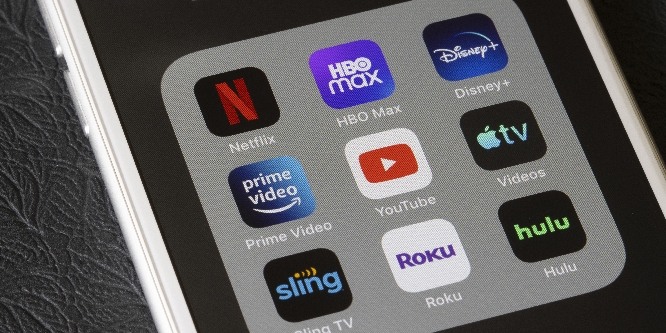
Photo: iStock | hapabapa
May 1, 2023
Is Streaming TV Retail Media’s Next Growth Driver?
The advertising potential of streaming platforms has entered the hype cycle as Netflix and Disney+ recently rolled out ad-supported streaming tiers. The retail media arms of Kroger, Best Buy and Instacart want in on the action.
Other ad-supported streaming platforms include Roku, Disney’s Hulu, Comcast’s Peacock, Paramount’s Pluto TV, and Amazon’s Freevee.
With a more robust value proposition for advertisers than linear TV (traditionally scheduled programming), streaming TV or connected TV (CTV) promises to allow advertisers to target audiences granularly based on data provided by the host platforms, such as zip code and viewing habits.
“Youth-obsessed advertisers are turning to streaming to reach younger people who have gravitated to those services and to find the legions of Americans who have ditched their traditional pay-TV packages altogether in favor of streaming. Brands also find streaming attractive because it often enables them to target ads to specific audiences, similar to the way digital ads have worked,” The Wall Street Journal reports.
First-party data from retail media networks (RMNs) has increasing appeal because it’s based on actual consumer behavior and purchases and due to the impending loss of third-party cookies.
Insider Intelligence predicts that more than 80 percent of RMNs’ placement will remain online for several years, but the next growth spurt will be off-site inventory from CTV to digital out-of-home and in-store.
As usual, the challenge is linking advertising to purchases.
Best Buy, in early March, agreed to allow Roku to use its customer purchasing data for ad-targeting.
Disney, in mid-April, partnered on a beta test that will let CPG firms tap Kroger shopper data to reach target audiences across select Disney inventory, starting with Hulu.
“Together with Disney, we’re building more meaningful moments with measurable brand impact,” said Cara Pratt, Kroger Precision Marketing SVP.
Instacart announced a partnership with Roku last week to enable advertisers to leverage purchasing data from more than 1,100 retail banners and over 80,000 stores in North America.
“Our partnership with Instacart makes it easier to measure actual return on advertising spend in e-commerce and meet consumers where they are – streaming TV,” said Alison Levin, VP of ad revenue and marketing solutions, Roku.
Discussion Questions
DISCUSSION QUESTIONS: Do streaming TV platforms have a targeting advantage over linear TV? What do you think of the potential marriage between retail media networks and streaming TV?
Poll
BrainTrust
Melissa Minkow
Director, Retail Strategy, CI&T
Ananda Chakravarty
Vice President, Research at IDC
Joel Rubinson
President, Rubinson Partners, Inc.
Recent Discussions







I was *just* thinking about this. I watched Jury Duty on Freevee over the last week, and it was advertising a product I bought recently on Prime — no doubt that data was connected. There are huge opportunities here, and while it may seem a bit creepy at first, I don’t think consumers would be that bothered since the ads will be extremely relevant.
Advertising on streaming TV platforms offers advertisers much more control to target specific customers based on purchase and viewing data. It might get a little creepy for consumers though.
Streaming TV and CTV will be the next advertising marker on the path to customer engagement. The ability to personalize based on viewing habits, known identity, and demographics will be powerful in defining how brands will advertise. Mix in the shopping perspective and even real-time linking to that cool new Tom Cruise aviator jacket and it will become even more compelling. The popularity of RMNs will grow at its own pace anyhow, but the intersection of CTV and RMN media will integrate shopping behavior and loyalty programs with customer viewing habits for even more privacy intrusion — but highly personal ads with higher ROAS.
As long as consumers continue to tolerate ads interrupting their streaming (something I am not convinced they will in large numbers), then advertising there is an ideal place for retail to be: targeted ads with potentially some tracking of purchases afterward. And I do mean targeted. A marketer’s dream.
To your point, Dave, nothing annoys me more than when I pick a show to watch on Prime and (since I didn’t pay attention) it streams on Freevee. There is nothing I have ever found that I want to watch that much. Yes, I immediately choose something else to watch without ads.
You and me both Gene. Ive been trying to figure out how to block FreeVee from my Amazon TV, (not likely to happen) and I get super annoyed when that app opens.
I agree with you Dave. At the moment, on my Alexa-operated Samsung TV, I still have the option to opt out of personalized ads. I’m not naive enough to think they aren’t still tracking. But between opting out and paying for higher tier streaming options that don’t have ads, I think I can tolerate some data gathering. If they ever get rid of the opt out service, I’ll ditch the OS and go to a streaming device that does allow me to opt out of personalization.
Streaming TV’s growth is soaring, as it offers more precise data on actual media consumption compared to linear TV.
As content and commerce converge, retail media will evolve with shoppable video to reach consumers where they already spend time.
Yes, exactly. I see a major push towards streaming and retail media will definitely need a plan to reach those consumers. For example, QVC has created a streaming service but, so far, it has been slow going to move regular customers or attract new customers to the streaming option. Time will tell the overall acceptance of shopping on the streaming options.
Streaming is definitely where the eyeballs are, and it also affords a more precise advertising target.
Streaming TV platforms have a great targeting advantage over linear TV. The data on the viewers is rich, and the viewers are locked in by choice.
The real question is how much viewers will put up with ads. My vote is “not at all.”
Gene,
As I mentioned in my comment, some will — but they aren’t likely to be the audience many advertisers are trying to reach. As I said, I’m with you when it comes to Freevee. Kill the ads and pass the popcorn.
Streaming offers unprecedented tracking of personas watching programming compared to linear TV. All devices or apps offer multiple profiles and continuously collect data about preferences and viewing habits. So yes, targeting will continue to get more granular, personal, and effective even on the go. The marriage between the two is logical and a natural progression.
Is the marriage between the two a logical and natural progression? The real question is, who will watch?
Well, for ad-supported platforms, the audience has no option but to watch. Even if they opt for the paid service, the devices themselves are displaying ads and learning to target audiences in many innovative ways. Think Amazon Firestick, Alexa, and all the apps/services under that umbrella… Think of watching live sports events without ads? Even if you fast forward, if recorded, notice all the banners. They learn a lot about personas by what they watch and all the related data getting to the event of selecting and clicking to view. Over time, they get more innovative and more targeted. Who will watch? if you have a device, you are watching, and they are collecting, and finding ways to target.
Collecting is not the issue. There is no doubt that the data available today is leagues richer and more usable than even a short time ago. I have no doubt that my data is being collected even as I stream on my no-advertising alternatives. The real question is who will choose to watch the ads? Maybe you. Not I.
I do not want to watch the ads either. I am saying that they are finding innovative ways to show us these ads.
Hopefully, for every innovative way, they come up with, someone matches them with an innovative way to avoid them. Since someone came up with a videotape machine to watch a recorded show, the fast-forward button has been embraced, and the trend to avoid ads has accelerated.
True, but think of banners during sports games or a drink during a show… that’s what I mean by alternative ways to track back to profiles and learn to target better.
I agree, George. I will watch an ad or two to see Aaron Judge hit a home run.
It’s clear that CTV offers better targeting and more data that makes a connection to RMNs very appealing for brands who want to reach the right consumer at the right time. This targeting technology will only improve over time and it’s definitely a part of the future for RMNs as they expand beyond e-commerce marketplaces.
Sure, there remains the question of just how many ads consumers will tolerate. Advertising is a way of life for many consumers who seek content but don’t want to pay the higher price to eliminate ads. And even when you do, most streaming platforms are still leveraging preroll ads and post-show ads in those higher priced tiers. The higher price just eliminates the ads in the middle of the programming and I expect this is the future of CTV as content creation continues to become more and more costly to lure those subscribers. Teaming with RMNs is another way for the streaming platform to recoup those content creation costs. It’s a win-win-win for brands, streaming platforms and RMNs. For consumers? We’ll see just how much is tolerated!
Potentially, anything has an advantage over anything else. In actuality people increasingly like uninterrupted content. This explains the growth of cable television, satellite radio, and so on. Is there an audience for commercially interrupted content? Of course. Is it the audience many advertisers are looking for? Not so much. Add to that the ongoing issue of linking advertising to purchasing and I think streaming TV platforms have a couple of hurdles to clear before it qualifies as marketing’s next digital magic wand. For now, I’m with Gene Detroyer. I’ll take my content minus the three minute blocks of advertising — oddly often in Spanish — that seem to regularly pop into Freevee broadcasts, generally at totally inappropriate moments. If I wanted ads, I wouldn’t be paying a small fortune every month to avoid them, and I’m betting Gene and I aren’t the only ones that feel this way.
Like you, I obviously do pay that “small fortune” to avoid ads and interruptions. The secret is I would pay even more to get more selection and no ads.
There is no reason not to do this–bringing together the two biggest growth areas in advertising. Shopper data has first party IDs that can be pushed for activation to the addressable TV platforms. In fact I already ran an experiment where we pushed frequent shopper IDs via Experian and LiveRamp to Roku. There were no issues at all making this work and there was a huge upside.
Forecasting the near future, eMarketer estimates that the bulk of TV viewership will crossover to digital by 2024. There’s good reason why the industry is transitioning from linear TV to CTV advertising:
-Reach
-Targeting
-Omnichannel
-Addressable
-Real-time optimization
-Impression-based measurement and attribution
Audiences are drawn to simple, effective, and helpful ads. As a result, more companies will look to roll out shoppable ad features to make the path to conversion even easier on OTT/CTV. I could see a merger of linear TV and connected TV appears to be a mixed model for buyers in the coming years.
I recall reading that Netflix are able to tell when a couple have had an argument – because their viewing habits change – it could well be that this level of insight – combined with what retailers know about customers provides phenomenal targeting capability.
It is also interesting to note how Amazon are now starting to sell specific products from their productions – the new production Citadel offers viewers the opportunity to buy specific products from the series – the clothing the stars wear for example. This is well beyond product placement and could well be a recipe for collaborations between retailers and film-makers.
In 2017, at the Channel Advisor conference in San Diego I debuted a future model for retail that broke things down into Mega-Ecosystems, Habitats (online and offline) and Platforms (Platform Retail). My theory on the latter was that Platforms like Netflix, Twitch, Roblox, Hulu would become central players in retailing and advertising. Six years later, the skepticism I was met with, has been proven wrong. Streaming services are in retail now and their presence will grow as a sales and marketing platform.
The first version of streaming TV platforms (digital on demand) was in the 1990’s as the cable tv industry was building out high speed digital networks. Dozens of start-ups were testing, promising true one-to-one media connections with customers. The promise then still holds today. Going deeper with customers will yield higher revenues and lasting loyalty if the customer feels what they are being offered aligns closely to them. Success is going to require this extra leg work to pay dividends.
We are working through a very transformative time in consumer goods and retail advertising.
Streaming platforms are replacing a significant chunk of traditional platforms, but there are so MANY streaming platforms to pick and choose from with plenty of overlap between them.
Retail media has no real choice but to participate if it wants to reach as many consumers as it did when traditional television was dominant. The targeting advantages are clear to party cloudy. Platforms such as Hulu claim to tailor our specific messaging to exactly the right audiences. But do they?
Do we yet have enough reliable data to know which demos stream what – – on what? The popular answer is yes, but the truthful answer is no.
For one, the loyalty to streaming platforms is volatile. Consumers are constantly adding, switching, combining, and overlapping.
One platform might be purchased only because a local sports team is on it, but that doesn’t mean the same viewer is tuned in to other programming on the same platform.
The popularity of one platform or another is quite fickle. And when a certain platform picks up a particular “series” it might get purchased for only the free trial, then cancelled.
What we have to keep in mind is that most platforms are expensive and without true bundles, consumers are very choosy but erratic.
But in any case, consumer goods and retail advertising need to use streaming platforms, trial and error, with constant attention to fluid changes, not year to year, not just season to season, but more effectively month to mouth. And every month is ratings season.
Web experiences have trained the new shoppers that data is being used to target ads to them. Most people I don’t think opt out even when prompted since they understand it is part of the subsidized experience. There will be a group that will opt out and as long as there is an easy option to do so, I don’t see an issue with it.